By: Haley Lesmerises, Interpretive Ranger at Franconia Notch State Park
It’s that time of year! Well, almost. The leaves on one of the trees outside the Hiker Cabin at Franconia Notch State Park are just beginning to change. Fall is just around the corner, and as a New England local that gets me wicked pumped for cozy sweaters, hot mulled cider and watching the foliage transform over the coming months.
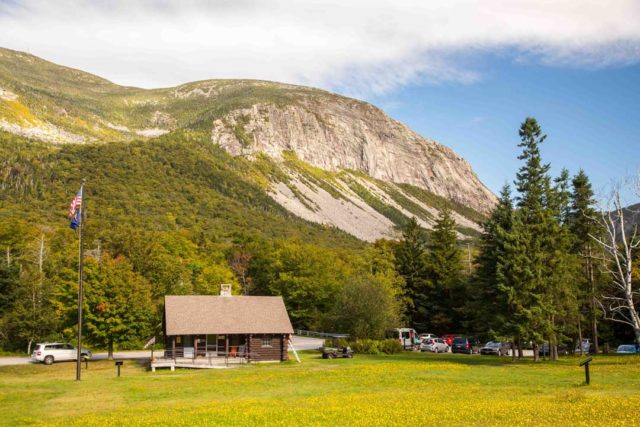
But besides the apple picking and pumpkin patches, there are other activities that many enjoy during Fall here in New Hampshire. One of these activities is the hunting of wild game, mainly deer. Deer hunting is a popular and often traditional pastime for many families in the Northeast. Hunters will spend many hours or often days in the field to pursue their catch. Though hunting is an activity that’s purpose is often to put food on the table or enjoy the challenges and rewards of the sport, it actually is an important part of wildlife management. Hunting acts as a population management tool and is important for keeping our ecosystems balanced and healthy.
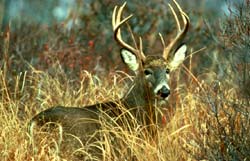
So let me tell you a story. I love animals; I always have and from a young age I knew that I wanted to grow up to study and protect wildlife. My dad is a hunter and that always weirded me out as a kid. He had antlers around the house and I would never touch the venison he sometimes cooked. We used to joke, “Dad, how am i going to be able to protect these animals if you keep eating them?” So I grew up not being a huge fan of hunting. That all changed my first semester of college. I walked into my Wildlife Ecology class, a nervous freshman but eager to begin learning about conservation. One of the first lessons we discussed was about wildlife population management. To my surprise my professor began discussing the importance of hunting and how it helps keep some ecosystems in balance. I left that class with a completely different view on the subject (and I thought maybe I’d try some of the venison next time I visited my dad). So for this blog post I hope to explain the science I learned in that class and talk about how we humans can be a productive part of the ecosystem around us.
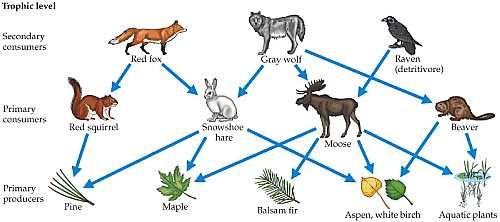
So, a bit of science first. In an ecosystem there are different species that prey on or are preyed upon by other animals. Commonly called a food chain, there are plants (producers) at the bottom which are eaten by herbivores (also called first level consumers). The herbivores are eaten by the next level up the food chain, carnivores (or second level consumers) and so on. There can be several layers of consumers (i.e. wolf > moose > aspen.) but at the top there is what is known at the top predator/ carnivore/ consumer. This top carnivore has a connection to not only the animals that it directly feeds on, but is also connected to what that species eats and so on. It has a sort of trickle down effect. What impacts the wolf can also impact the aspen. Top carnivores can also impact animals that they are even less connected to. As you can see from the diagram above, there is no direct line from the red fox to the beaver. However, red fox feed on snowshoe hare which feed on aspen. Beaver also feed on aspen. In this way, the fox can have an effect on the beaver indirectly.
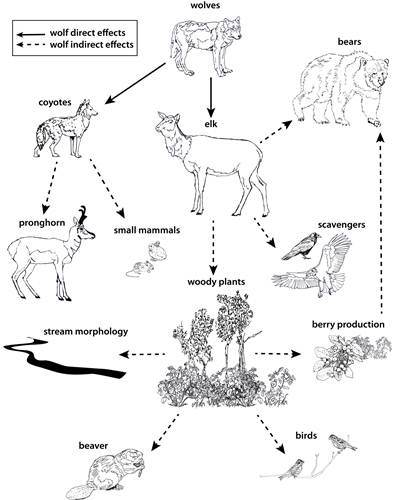
Where am I going with all of this? Here is a model that we used in school. It’s a simplified model of the food web present in Yellowstone National Park. Here wolves are the apex predator. Wolves feed primarily on the elk, which then feed on the woody plants that are especially present along rivers. Looking at the diagram, you can see that other animals depend on the woody plants, mainly birds and beavers. In each ecosystem there is a certain number for each species called the carrying capacity. When a species reaches carrying capacity it means that that is the maximum number of those animals that the ecosystem can support. When a species goes beyond carrying capacity, the ecosystem can struggle. When wolves are present the elk population is kept below their carrying capacity through that predation. Meaning that the wolves eat enough elk to keep their numbers within the ecosystems means. This also means that there are enough woody plants for animals like beaver and birds because there are not too many elk eating them. But, say we take wolves out of the equation. Now the elk have no large predators and so their numbers skyrocket. There are more elk than before eating all of the woody plants. Now there are not enough plants to support birds, and beaver. Simply put, the presence or absence of top carnivores has a huge effect on the ecosystem and the species with in it.
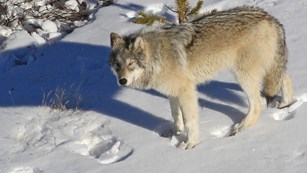
Now you may be wondering why I showed you a model of wolves when I said I would be talking about hunting in New Hampshire. You may be thinking, “but there are no wolves in New Hampshire!” and to that I would say you are exactly right! There are no wolves in New Hampshire, but there used to be. Wolves were extirpated (driven out) of New Hampshire in the early 1800’s because they used to attack sheep. With the last of the wolves driven out we had lost our top carnivore, but now, humans have stepped into that position. Deer had always been hunted here but it wasn’t until 1909, in the early days of the NH Fish and Game Department, that hunting licences were required in NH. Today, an average of 11,000 deer are harvested annually. That may sound like a lot but each season is carefully planned out by Fish and Game scientists to ensure that population goals are being met. When hunters harvest a deer they take it to a check station where data is collected from the deer. Scientists collect measurements from harvested deer and information from hunters to better understand trends in populations and herd health. All of this data is combined with science on natural mortality and used to create a plan for the next season to ensure that the population is well managed. Not only that but there is a tax that was established by the Wildlife Restoration Act in 1937 on all firearms and ammunition. The money from this tax helps to fund wildlife research and restoration and also habitat protection within the state.
If you are interested in learning more about hunting and population management in New Hampshire, check out the NH Fish and Game website. They have lots of information on regulations and safety information, NH’s “Hunt for the Hungry” program, hunting with disabilities, wild game recipes and so much more!

I understand the necessity of keeping some of the population of certain animals down. However every time I see a baby bunny in the street that has been hit by a car or even a deer that the police had to shoot because he was so badly injured my heart breaks. Thank you for this article. It is a good reminder of the necessity of thinning the populations of some species.
A great article on the balance required to maintain the extraordinary and complicated ego system . I am always amazed at what we have in our New Hampshire forest and so thankful to people like you who work for us to keep it that way🦉🙏